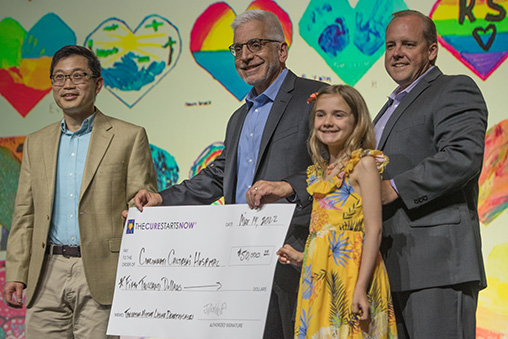Research And Grants

Cincinnati Children's Hospital – $50,000
Dr. Richard Lu
$50,000.00
May 2022
Translational
DIPG / DMG
Targeting Histone Lysine Demethylases to Treat Diffuse Intrinsic Pontine Glioma
Diffuse midline gliomas (DMG), including diffuse intrinsic pontine glioma (DIPG) are the most aggressive pediatric tumor arising in the ventral pons with a median survival time of 9 months and a fatality rate of more than 99% 1-3. Chemotherapy and radiotherapy fail to extend the survival of patients beyond few months 4. Currently there are no effective treatment for DMG/DIPG, which are universally lethal. Epigenetic dysregulation is considered to be central for DMG/DIPG oncogenesis and treatment resistance 5-7. A global histone hypomethylation due to a K27M mutation in histone 3.1 and 3.3 disrupts normal chromatin remodeling and cell cycle regulation, allowing oncogenic drivers to accelerate cancer progression 8. The hypomethylation is further aggravated by histone lysine demethylases that remove methyl groups from existing trimethylated lysine27 (K27me3) 8,9.
Targeting histone lysine demethylases (KDM6A and/or KDM6B) with small molecule inhibitor, GSKJ4, has resulted in potent antitumor activity in K27M mutated DIPG compared to K27 wild type glioblastoma 10. However, the location of tumor in the brain stem creates accessibility issues necessitating intraperitoneal injections of 100 mg/kg of GSKJ4 daily in mice for 10 days thereby greatly exceeding the IC50 of 1.3 to 3 µM 10. In addition, GSKJ4 may exhibit side effects at a high dose11,12. To address these issues to achieve target specific KDM6A/B silencing, our collaborator Dr. Nalini Mehta has developed Adeno-Associated Virus (AAV) carrying CRISPR guide RNA (gRNA) and dSaCas9-KRAB that transcriptionally downregulate KDM6A/B. AAVs have been shown to efficiently transduce cells in the CNS and are clinically approved for therapies 13,14. Once expressed, the dSaCas9-KRAB can bind to a gRNA targeted promoter and silence transcription of the corresponding gene 15. The preliminary data show that DIPG tumor bearing mice treated with KDM6A/B silencing AAVs exhibit a significant increase in lifespan. Strikingly, there were more than 80% overall survival with treatment groups relative to 17% survival in the control groups in DIPG forming mice. Thus, we hypothesize that KDM6A/B serve as a potential target to block DIPG tumorigenesis. The AAV- CRISPR system can potentially serve as a platform to silence multiple oncogenic pathways that induce DIPG tumorigenesis.

